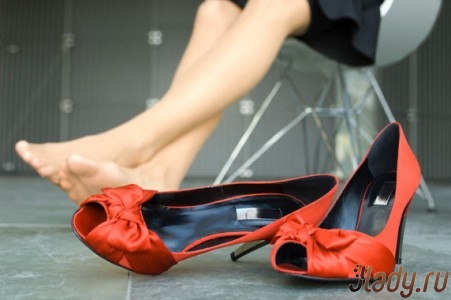 Every woman's wardrobe contains shoesheels. Although our feet don't feel very comfortable in high heels, we can't deny ourselves the desire to look more attractive. After all, you must admit that any woman in high heels looks slimmer and sexier. Let's take an example from the main characters of the TV series "Sex and the City", who almost never part with heels: they go not only to work and parties, but also even run and walk the dog. According to statistics, every tenth modern woman wears high heels at least three days a week, and does not think that she is harming her health. According to British scientists, regular walking in high heels leads not only to damage to tendons and joints, curvature of the foot, pinching of the spinal nerves, but even weakening of mental abilities. Now let's talk about everything in order. Firstly, high heels deform the front part of the foot. Due to the increased pressure exerted during walking, the toes have to squeeze unnaturally. At the same time, a narrow shoe last only aggravates the situation. All this leads to the appearance of "bones" and growths. It is enough to look at Victoria Beckham's feet to see what an excessive passion for high-heeled shoes leads to. Now she will have an operation to remove the cones. Unfortunately, Victoria is not alone in her suffering. Models Iman and Naomi Campbell and actress Tilda Swinton have the same problem with their feet. Another problem with their feet awaits high-heeled lovers - the Achilles tendon, which most often makes itself known not immediately, but after about ten years of regular wearing of high heels. Due to the unnatural position of the tendon, which runs from the heel to the calf muscles, it shrinks and becomes less flexible. Therefore, with age, it becomes increasingly difficult to walk in flat shoes (after all, the tendon has already become accustomed to the rise), fast walking or running cause the same pain as with a sprain. High heels also have a negative effect on posture. They also increase the risk of pinched vertebrae, which leads to sharp pain in the neck and lower back, and then to radiculitis. Not to mention that when falling, you can get not only a dislocated joint, but also a broken ankle. We recommend reading:
Every woman's wardrobe contains shoesheels. Although our feet don't feel very comfortable in high heels, we can't deny ourselves the desire to look more attractive. After all, you must admit that any woman in high heels looks slimmer and sexier. Let's take an example from the main characters of the TV series "Sex and the City", who almost never part with heels: they go not only to work and parties, but also even run and walk the dog. According to statistics, every tenth modern woman wears high heels at least three days a week, and does not think that she is harming her health. According to British scientists, regular walking in high heels leads not only to damage to tendons and joints, curvature of the foot, pinching of the spinal nerves, but even weakening of mental abilities. Now let's talk about everything in order. Firstly, high heels deform the front part of the foot. Due to the increased pressure exerted during walking, the toes have to squeeze unnaturally. At the same time, a narrow shoe last only aggravates the situation. All this leads to the appearance of "bones" and growths. It is enough to look at Victoria Beckham's feet to see what an excessive passion for high-heeled shoes leads to. Now she will have an operation to remove the cones. Unfortunately, Victoria is not alone in her suffering. Models Iman and Naomi Campbell and actress Tilda Swinton have the same problem with their feet. Another problem with their feet awaits high-heeled lovers - the Achilles tendon, which most often makes itself known not immediately, but after about ten years of regular wearing of high heels. Due to the unnatural position of the tendon, which runs from the heel to the calf muscles, it shrinks and becomes less flexible. Therefore, with age, it becomes increasingly difficult to walk in flat shoes (after all, the tendon has already become accustomed to the rise), fast walking or running cause the same pain as with a sprain. High heels also have a negative effect on posture. They also increase the risk of pinched vertebrae, which leads to sharp pain in the neck and lower back, and then to radiculitis. Not to mention that when falling, you can get not only a dislocated joint, but also a broken ankle. We recommend reading:

Making Money with Desserts: Success Stories
Evgeniya Polischuk (Fedutinova) instagram:@evgeniyafedutinovavk.com/janeshomebaking– It all started with baking for family and friends. Gradually, I started posting photos of my baked goods on Instagram – and orders started coming in. I made my first custom-made cake on October 13, 2014, and a little earlier I started making macaroons and cupcakes. You could say that the business “found me”, I am very […]

Soups are cold recipes with photos
Cold cucumber soup with yogurt and lemonsorbet from the chef of the restaurant La Taverna Alexander Zhurkin Photo: Getty Images Ingredients: Plain yoghurt – 125 g Cucumber – 150 g Lemon/lime sorbet – 50 g Cocktail shrimp – 24 g Fresh ginger juice – 1 g Lime juice – 5 g Fresh orange juice – 5 g Parsley – 1 g Pink pepper – 1 g Watercress – […]

barbeque kebab
Pork tenderloin in glaze Photo:Dmitry Bayrak/dbstudioPreparation time: 20 minutes + marinating time.Calories: 454 kcal per serving.For 4 servings: 4 pork tenderloins (approximately 300 g each), 1 onion, 2 cloves of garlic, 1 tsp. lemon zest, 1 tsp. lemon juice, a pinch of ground cumin, coriander and turmeric, 1 tbsp. vegetable […]

Pierre Duacan: dietary recipes: Ducane diet
Beetroot soup Photo:Season’S, Luxury Hotels RepresentationYou will need:· Boiled beetroot – 60 g· Fresh cucumbers – 20 g· Red radish – 20 g· Green onions – 10 g· Egg – 1 pc.· Drinking mineral water – 200 g· Salt – 1 gPreparation:· Boil the egg and beetroot.· Grate the cucumbers, radish and part of the beetroot. Put everything […]





